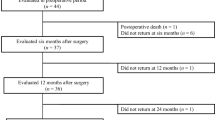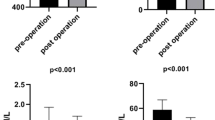Abstract
Background
This study examined the effect of weight loss on energy intake, vitamin C, E, β-carotene (diet/blood), reduced glutathione (GSH), C-reactive protein (CRP), thiobarbituric acid reactive substances (TBARS), catalase, and myeloperoxidase, in patients with Roux-en-Y bypass gastroplasty.
Methods
Prospective clinical study with control (C) and bariatric (B) groups (n = 20 each). Age was 38.8 ± 11.1 (C) and 37.8 ± 11.2 years (B), and body mass indices (BMI) were 22.4 ± 2.4 and 48.1 ± 8.7 kg/m2, respectively. Group C was assessed on a single occasion and B at three time points (basal period and 3 and 6 months after gastroplasty).
Results
BMI was decreased at three (38.3 ± 1.7, P = 0.018) and 6 months after surgery (34.9 ± 1.7, P < 0.001). Mean weight loss was 20.53 ± 1.1 after three and 27.96 ± 1.3 kg after 6 months. Serum vitamin C and β-carotene (P < 0.01 and P < 0.001, respectively) were increased at 6 months compared to basal. Basal serum vitamin C (P = 0.001) and β-carotene (P < 0.001) were lower compared to controls. Serum vitamin E corrected for cholesterol and triglycerides was higher in group B at three (P = 0.01) and 6 months (P = 0.001) and lower at basal (P < 0.001) compared to controls. GSH was higher in controls (P < 0.001) compared to basal. Catalase (P = 0.01) and TBARS (P < 0.001) were higher in group B at 6 months. TBARS were higher (P < 0.001) at basal compared to controls. Myeloperoxidase and CRP decreased in group B after three (P = 0.028, P = 0.010) and 6 months (P < 0.001, P = 0.001), respectively.
Conclusions
Roux-en-Y bypass gastroplasty led to decreased proinflammatory parameters together with increased nutritional antioxidants, catalase, and TBARS, and decreased GSH 6 months after surgery.
Similar content being viewed by others
References
World Health Organization (WHO). Obesity: preventing and managing the global epidemic. Report of a WHO consultation on obesity. Geneva: WHO/NUT/NCD/981, 1998.
Higdon JV, Frei B. Obesity and oxidative stress: a direct link to CVD? Arterioscler Thromb Vasc Biol. 2003;23:365–7.
Uzun H, Zengin K, Taskin M, et al. Changes in leptin, plasminogen activator factor and oxidative stress in morbidly obese patients following open and laparoscopic Swedish adjustable gastric banding. Obes Surg. 2004;14:659–65.
Halliwell B, Gutteridge JMC. Oxygen is a toxic gas – an introduction to oxygen toxicity and reactive oxygen species. In: Free Radicals in Biology and Medicine. Oxford: Clarendon Press 1999:1-35.
Fang YZ, Yang S, Wu G. Free radicals, antioxidants and nutrition. Nutrition. 2002;18:872–9.
Kelling PL, Smith LL. Relevance of NADPH depletion and mixed disulphide formation in rat lung to the mechanism of cell damage following paraquat administration. Biochem Pharmacol. 1982;31:3243–9.
Mohn A, Catino M, Capanna R, et al. Increased oxidative stress in prepubertal severely obese children: effect of a dietary restriction-weight loss program. J Clin Endocrinol Metab. 2005;90:2653–8.
Arnhold J. Properties, functions, and secretion of human myeloperoxidase. Biochemistry. 2004;69:8–15.
Galan P, Viteri FE, Bertrais S, et al. Serum concentrations of β-carotene, vitamins C and E, zinc and selenium are influenced by sex, age, diet, smoking status, alcohol consumption and corpulence in a general French adult population. Eur J Clin Nutr. 2005;59:1181–90.
Strauss RS. Comparison of serum concentrations of alpha-tocopherol and beta-carotene in a cross-sectional sample of obese and non-obese children (NHANES III). J Pediatr. 1999;134:160–5.
Sies H, Stahl W. Vitamins E and C, β-carotene and other carotenoids as antioxidants. Am J Clin Nutr. 1995;62:15S–21S. Suppl 13.
Jung R. Obesity as a disease. Br Med Bull. 1997;53:307–21.
Deitel M, Shahi B, Deitel FH. Effect of weight loss in the morbidly obese patient with severe disability. Obes Surg. 1991;1:419–21.
Mango VL, Frishman WH. Physiologic, psychologic, and metabolic consequences of bariatric surgery. Cardiol Rev. 2006;14:232–7.
Buchwald H. The future of bariatric surgery. Obes Surg. 2005;15:598–605.
van Stijn MFM, Boelens PG, Richir MC, et al. Antioxidant-enriched enteral nutrition and immuno-inflammatory response after major gastrointestinal tract surgery. Br J Nutr. 2010;103:314–8.
Xu J, Yunshi Z, Li R. Immunonutrition in surgical patients. Curr Drug Targets. 2009;10:771–7.
Kücükakin B, Gögenur I, Reiter RJ, et al. Oxidative stress in relation to surgery: is there a role for the antioxidant melatonin? J Surg Res. 2009;152:338–47.
Malinowski SS. Nutritional and metabolic complications of bariatric surgery. Am J Med Sci. 2006;331:219–25.
Alvarez-Leite J. Nutrient deficiencies secondary to bariatric surgery. Curr Opin Clin Nutr Metab Care. 2004;7:569–75.
Melissas J, Malliaraki N, Papadakis JA, et al. Plasma antioxidant capacity in morbidly obese patients before and after weight loss. Obes Surg. 2006;16:314–20.
World Medical Association (WMA). Declaration of Helsinki. Edinburgh, Scotland: 52nd General Assembly-WMA. 2000. [cited 2006 Feb 25]; Available from: URL: http://www.wma.net
World Health Organization (WHO). Physical Status: the use and interpretation of anthropometry. WHO technical report series 854. Geneva: WHO, 1995. 453p.
Sichieri R, Everhart JE. Validity of a Brazilian frequency questionnaire against dietary recalls and estimated energy intake. Nutr Res. 1998;18:1649–59.
Willet W, Stampfer MJ. Total energy intake: implications for epidemiologic analyses. Am J Epidemiol. 1986;124:17–27.
United States Department of Agriculture (USDA). Available at: http://www.nal.usda.gov/fnic/foodcomp/search/. Accessed on: 6 May 2007.
Bessey OA. Ascorbic acid microchemical methods. In: Gyorgy P, editor. Vitamin methods. New York: Academic Press; 1960. p. 303.
Arnauld J, Fortis I, Blachier S, et al. Simultaneous determination of retinol, alpha-tocopherol and beta-carotene in serum by isocratic high-performance liquid chromatography. J Chromatogr. 1991;572:103–16.
Nagaya T, Nakaya K, Yoshida I, et al. Comparison of indices for serum vitamin E status in healthy subjects. Clin Chim Acta. 1998;276:103–8.
Beutler E, Duron O, Kelly BM. Improved method for the determination of blood glutathione. J Lab Clin Med. 1963;61:882–90.
Aebi H. Catalase in vitro. Methods Enzymol. 1984;105:121–6.
Rao TS, Curie JL, Shaffer AF, et al. Comparative evaluation of arachidonic acid (AA) and tetradecanoylphorbol acetate (TPA)-induced dermal inflammation. Inflamm. 1993;17:723–41.
Whicher JT, Ritchie RF, Johnson AM, et al. New international reference preparation for proteins in human serum (RRPHS). Clin Chem. 1994;40:934–8.
Baudner S, Bienvenu J, Blirup-Jensen S et al. The certification of a matrix reference material for immunochemical measurement of 14 human serum proteins. CRM 470. Brussels: community bureau of reference, commission of the European communities, 1993:1-172.
Ohkawa H, Oshishi N, Yagi K. Assay for lipid peroxides in animal tissues by thiobarbituric acid reaction. Anal Biochem. 1979;95:351–8.
Bird RP, Draper AH. Comparative studies on different methods of malondyaldehyde determination. Meth Enzymol. 1984;105:295–305.
Kisakol G, Guney E, Bayraktar F, et al. Effect of surgical weight loss on free radical and antioxidant balance: a preliminary report. Obes Surg. 2002;12:795–800.
Dias MCG, Ribeiro AG, Scabim VM, et al. Dietary intake of female bariatric patients after anti-obesity gastroplasty. Clinics. 2006;61:93–8.
Bernet CP, Ciangura C, Coupaye M, et al. Nutritional deficiency after gastric bypass: diagnosis, prevention and treatment. Diabete Metab. 2007;33:13–24.
Khan NI, Naz L, Yasmeen G. Obesity: an independent risk factor for systemic oxidative stress. Pak J Pharm Sci. 2006;19:62–5.
Moor de Burgos A, Wartanowicz M, Ziemlanski S. Blood vitamin and lipid levels in overweight and obese women. Eur J Clin Nutr. 1992;46:803–8.
Faber P, Johnstone AM, Gibney ER, et al. The effect of rate of weight loss on erythrocyte glutathione concentration and synthesis in healthy obese men. Clin Sci. 2002;102:569–77.
Uzun H, Konukoglu D, Gelisgen R, et al. Plasma protein carbonyl and thiol stress before and after laparoscopic gastric banding in morbidly obese patients. Obes Surg. 2007;17:1367–73.
Furukawa S, Fujita T, Shimabukuro M, et al. Increased oxidative stress in obesity and its impact on metabolic syndrome. J Clin Invest. 2004;114:1752–61.
Dandona P, Mohanty P, Ghanim H, et al. The suppressive effect of dietary restriction and weight loss in the obese on the generation of reactive oxygen species by leukocytes, lipid peroxidation, and protein carbonylation. J Clin Endocrinol Metab. 2001;86:355–62.
Kirkman HN, Gaetani GF. Mammalian catalase: a venerable enzyme with new mysteries. Trends Biochem Sci. 2007;32:44–50.
Zhang R, Brennan ML, Zhongzhou S, et al. Myeloperoxidase functions as a major enzymatic catalyst for initiation of lipid peroxidation at sites of inflammation. J Biol Chem. 2002;277:46116–22.
Cabrera EJ, Valezi AC, Delfino VDA, et al. Reduction in plasma levels of inflammatory and oxidative stress indicators after Roux-en-Y Gastric Bypass. Obes Surg. 2010;20:42–9.
van Dielen FMH, Buurman WA, Hadfoune M, et al. Macrophage inhibitory factor, plasminogen activator inhibitor-1, other acute phase proteins, and inflammatory mediators normalize as a result of weight loss in morbidly obese subjects treated with gastric restrictive surgery. J Clin Endocrinol Metab. 2004;89:4062–8.
Barbosa E, Faintuch J, Moreira EAM, et al. Supplementation of vitamin E, C and zinc attenuates oxidative stress in burned children: a randomized, double-blind, placebo-controlled pilot study. J Burn Care Res. 2009;30:859–66.
Acknowledgments
The authors are grateful to the following for financial support: Fundação de Apoio à Pesquisa Científica e Tecnológica do Estado de Santa Catarina (FAPESC): Grant no. CON 14191/2007-7; Conselho Nacional de Desenvolvimento Científico e Tecnológico - CNPq, Programa Institucional de Bolsa de Iniciação Científica - Conselho Nacional de Desenvolvimento Científico e Tecnológico, and Coordenação de Aperfeiçoamento de Pessoal de Nível Superior - CAPES. Statement of authorships: Moreira, Fröde, Wilhelm Filho had full access to all of the data in the study and take responsibility for the integrity of the data and the accuracy of the data analysis. Study concept and design: Moreira, Fröde, Wilhelm Filho. Acquisition of data: Boesing. Analysis and interpretation of data: Vigil, Parizotto, Inácio, Portinari, Trindade, Jordão Júnior. Drafting of the manuscript: Moreira, Fröde, Wilhelm Filho. Critical revision of the manuscript for important intellectual content: Moreira, Fröde, Wilhelm Filho. Statistical analysis: Boesing, Moreira. Final approval of the version to be submitted: Moreira, Fröde, Wilhelm Filho. Obtained funding: Moreira, Trindade.
Conflict of Interest Statement
No conflict of interest needs to be reported; the funding agency had no role in the analysis or interpretation of the data or in the decision to submit the report for publication.
Author information
Authors and Affiliations
Corresponding author
Rights and permissions
About this article
Cite this article
Boesing, F., Moreira, E.A.M., Wilhelm-Filho, D. et al. Roux-en-Y Bypass Gastroplasty: Markers of Oxidative Stress 6 Months After Surgery. OBES SURG 20, 1236–1244 (2010). https://doi.org/10.1007/s11695-010-0196-x
Published:
Issue Date:
DOI: https://doi.org/10.1007/s11695-010-0196-x




